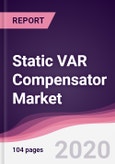What is Static VAR Compensator?
Static VAR Compensator, is a set of devices which stabilize voltage output in order to maintain or control few specific parameters required for the Industrial application. The device is variable impedance in which the current flows through the device is controlled by bidirectional thyristor valves. SVC consists of two main combinational components such as: Thyristor-controlled Reactor and Thyristor switched reactor and Thyristor switched Capacitor.
What are the major applications of Static VAR Compensator?
The primary application of SVC is to reduce voltage variations in the power system. Nowadays, many large industries, specifically steel industries consistently uses SVC for the purpose of flicker compensation in the installation of electric arc furnace. In addition to that, SVC are also installed at appropriate spots in the electric circuit system to reduce its potentiality to transfer by improving its voltage stability.
Market Research and Market Trends of Static VAR Compensator
- Patented Main Reactor SVC Design. This Patented Main Reactor SVC design is personalized based on the industries key requirements for the performance of the system. In typical SVC medium, the bus is directly connected to the SVC coupling transformer, but with this new design, there is reactor which acts as a connector between the bus and the coupling transformer. This design demands fewer harmonic filters allowing a closely-packed, optimized SVC Layout.
- Advanced Thyristor Valve for SVC System. This Advanced SVC system is GE’s recent development liquid cooled thyristor valve for SVC applications. This new designed valves have been developed from GE’s substantial exposure of using thyristor based SVC’s for both industrial application and transmission. The ATV gives a closely-packed, flexible and consistent platform for both TSC and TCR variants.
- Siemens providing first-of-its-kind grid stability technology – Mobile SVC Plus. Siemens, will introduce Mobile SVC Plus, which is first-of-its-kind grid stability technology. This SVC keeps the grid stable during any kind of interference and imperfection by providing rapid and restrained reactive power. This technology provides industries an unparalleled level of feasibility to move the device anywhere required, especially in situations of unexpected failures events.
- Advanced Digital Control for SVC System. This GE’s approach to SVC system presents an innovative design by using its powerful Model based design approach. In this approach, essential library of complex control algorithm has been used to build SVC Control system software. In Model base design, Graphical Programming Interface (GPI) has been used to simplify the programming and personalize the control functions. This GPI is also used in translation of control models with automatic code generations for all verification and testing stages.
Who are the Major Players in market?
The key players operating in the market are General Electronics, ABB Ltd, Siemens AG Schneider, Fuji Electronics, Mitsubishi Electric Corporation, and American Electric Power and more than 20 companies are included in this report.
What is our report scope?
The report incorporates in-depth assessment of the competitive landscape, product market sizing, product benchmarking, market trends, product developments, financial analysis, strategic analysis and so on to gauge the impact forces and potential opportunities of the market. Apart from this the report also includes a study of major developments in the market such as product launches, agreements, acquisitions, collaborations, mergers and so on to comprehend the prevailing market dynamics at present and its impact during the forecast period 2020-2025.
Key Takeaways from this Report
- Evaluate market potential through analyzing growth rates (CAGR %), Volume (Units) and Value ($M) data given at country level – for product types, end use applications and by different industry verticals.
- Understand the different dynamics influencing the market – key driving factors, challenges and hidden opportunities.
- Get in-depth insights on your competitor performance – market shares, strategies, financial benchmarking, product benchmarking, SWOT and more.
- Analyze the sales and distribution channels across key geographies to improve top-line revenues.
- Understand the industry supply chain with a deep-dive on the value augmentation at each step, in order to optimize value and bring efficiencies in your processes.
- Get a quick outlook on the market entropy – M&A’s, deals, partnerships, product launches of all key players for the past 4 years.
- Evaluate the supply-demand gaps, import-export statistics and regulatory landscape for more than top 20 countries globally for the market.
Table of Contents
Methodology

LOADING...








